Effect of the Coordinative Optimization of Interruptible Loads in Primary Frequency Regulation on Frequency Recovery
Abstract
:1. Introduction
2. The Cost of Using Direct Load Control (DLC) for Primary Frequency Regulation
2.1. The Cost of DLC
2.2. The Cost of a Primary Frequency Regulation Reserve
3. Impacts of the Primary Frequency Regulation Reserve Provided by DLC and Generating Units on Frequency Recovery
3.1. Impacts of DLC on Frequency Recovery
3.2. Impacts of the Generating Units on Frequency Recovery
4. Optimization Model
5. Case Study
5.1. Parameters of the Case Study
5.2. Comparison of Economy under Circumstances with and without DLC
5.3. Comparison of Frequency Recovery Effects under Circumstances with and without DLC
5.4. Impacts of Different Factors on the Optimization Results
5.4.1. Impacts of the Proportion of DLC on the Optimization Results
5.4.2. Impacts of the DLC and Generator Parameters on the Optimization Results
5.4.3. Impacts of the Probabilities of the Active Power Shortage Scenarios on the Optimization Results
6. Conclusions
Acknowledgments
Author Contributions
Conflicts of Interest
References
- Peng, C.; Lei, S.; Hou, Y.; Wu, F. Uncertainty management in power system operation. CSEE J. Power Energy Syst. 2015, 1, 28–35. [Google Scholar] [CrossRef]
- Hong, Y.-Y.; Lai, Y.-M.; Chang, Y.-R.; Lee, Y.-D.; Liu, P.-W. Optimizing capacities of distributed generation and energy storage in a small autonomous power system considering uncertainty in renewables. Energies 2015, 8, 2473–2492. [Google Scholar] [CrossRef]
- Park, H.-G.; Lyu, J.-K.; Kang, Y.; Park, J.-K. Unit commitment considering interruptible load for power system operation with wind power. Energies 2014, 7, 4281–4299. [Google Scholar] [CrossRef]
- Khorsand, M.A.; Heydari, H.; Zakariazadeh, A. Interruptible load participation as operating reserve in joint energy and spinning reserve markets using stochastic security analysis. In Proceedings of the 2nd International Conference on Computer and Automation Engineering, Singapore, 26–28 February 2010; pp. 8–12.
- Aminifar, F.; Fotuhi-Firuzabad, M.; Shahidehpour, M. Unit commitment with probabilistic spinning reserve and interruptible load considerations. IEEE Trans. Power Syst. 2009, 24, 388–397. [Google Scholar] [CrossRef]
- Nouri, A.; Afkousi-Paqaleh, M.; Hosseini, S.H. Probabilistic assessment and sensitivity analysis of marginal price of different services in power markets. IEEE Syst. J. 2013, 7, 873–880. [Google Scholar] [CrossRef]
- Shen, J.; Jiang, C.; Li, B. Controllable load management approaches in smart grids. Energies 2015, 8, 11187–11202. [Google Scholar] [CrossRef]
- Aunedi, M.; Kountouriotis, P.; Calderon, J.E.; Angeli, D.; Strbac, G. Economic and environmental benefits of dynamic demand in providing frequency regulation. IEEE Trans. Smart Grid 2013, 4, 2036–2048. [Google Scholar] [CrossRef]
- Paterakis, N.G.; Erdinc, O.; Bakirtzis, A.G.; Catalao, J.P.S. Qualification and quantification of reserves in power systems under high wind generation penetration considering demand response. IEEE Trans. Sustain. Energy 2015, 6, 88–103. [Google Scholar] [CrossRef]
- Ma, L.L.; Yang, J.; Fu, C.; Liu, P.; Sun, Y.Z. Review on impact of electric car charging and discharging on power grid. Power Syst. Prot. Control 2013, 3, 140–148. [Google Scholar]
- Zhao, H.; Liu, G.; Jia, H.; Yang, Z.; Fan, S. Analysis of demand response program based on refined models. Power System Protection and Control 2014, 1, 62–69. (In Chinese) [Google Scholar]
- Yoo, T.H.; Park, H.; Lyu, J.K.; Park, J.K. Determining the interruptible load with strategic behavior in a competitive electricity market. Energies 2014, 8, 257–277. [Google Scholar] [CrossRef]
- Douglass, P.J.; Garcia-Valle, R.; Nyeng, P.; Ostergaard, J.; Togeby, M. Smart demand for frequency regulation: Experimental results. IEEE Trans. Smart Grid 2013, 4, 1713–1720. [Google Scholar] [CrossRef]
- Chen, H.; Chen, Y.; Wan, Q.; Gao, S. Steady-State Analysis of Power System, 3rd ed.; China Electric Power Press: Beijing, China, 2007; pp. 201–218. (In Chinese) [Google Scholar]
- Wang, D. Theory and Empirical Research on Electric Power Demand Response. Ph.D. Thesis, North China Electric Power University, Beijing, China, 2011. [Google Scholar]
- Hu, Z.; Xie, X.; Zhang, F.; Zhang, J.; Song, Y. Research on automatic generation control strategy incorporating energy storage resources. Proc. CSEE 2014, 29, 5080–5087. (In Chinese) [Google Scholar]
- Lei, B. Research on Application of Battery Energy Storage System in Power System Frequency Regulation. Ph.D. Thesis, Hunan University, Changsha, Hunan, China, 2014. [Google Scholar]
- Yao, J.; Yang, S.; Wang, K.; Zeng, D.; Mao, W.; Geng, J. Framework and strategy design of demand response scheduling for balancing wind power fluctuation. Autom. Electr. Power Syst. 2014, 9, 85–92. (In Chinese) [Google Scholar]
- Zhang, W.; Lian, J.; Chang, C.Y.; Kalsi, K. Aggregated modelling and control of air conditioning loads for demand response. IEEE Trans. Power Syst. 2013, 28, 4655–4664. [Google Scholar] [CrossRef]
- Xiao, X.; Zhou, Y.; Zheng, K.; Chen, J.; Zhang, N.; Zhou, Y. Research on strategy of interruptible price and its cost-benefit model aimed at peak load shifting in Taiwan. Proc. CSEE 2014, 22, 3615–3622. (In Chinese) [Google Scholar]
- Wu, D.; Aliprantis, D.C.; Ying, L. Load scheduling and dispatch for aggregators of plug-in electric vehicles. IEEE Trans. Smart Grid 2012, 3, 368–376. [Google Scholar] [CrossRef]
- Xu, Y.; Liu, W.; Gong, J. Stable multi-agent-based load shedding algorithm for power systems. IEEE Trans. Power Syst. 2011, 6, 2006–2014. [Google Scholar]
- Daneshfar, F.; Bevrani, H. Load-frequency control: A GA-based multi-agent reinforcement learning. IET Gener. Transm. Distrib. 2010, 4, 13–26. [Google Scholar] [CrossRef]
- Wang, K.; Yao, J.; Yao, L.; Yang, S.; Yong, T. Survey of Research on Flexible Loads Scheduling Technologies. Autom. Electr. Power Syst. 2014, 20, 127–135. (In Chinese) [Google Scholar]
- China National Energy Administration. DL/T 428-2010 Technical Rules for Power System Automatic Under-Frequency Load Shedding; Electric Power Press: Beijing, China, 2011; pp. 1–2. [Google Scholar]
- Lin, Y.; Chen, X.; Zheng, X.; Bie, Z. Estimation of spinning contingency reserve capacity in power systems. Autom. Electr. Power Syst. 2014, 19, 114–121. (In Chinese) [Google Scholar]
- Wang, D. Application of incentive demand response in USA. Power Demand Side Manag. 2010, 1, 74–77. [Google Scholar]

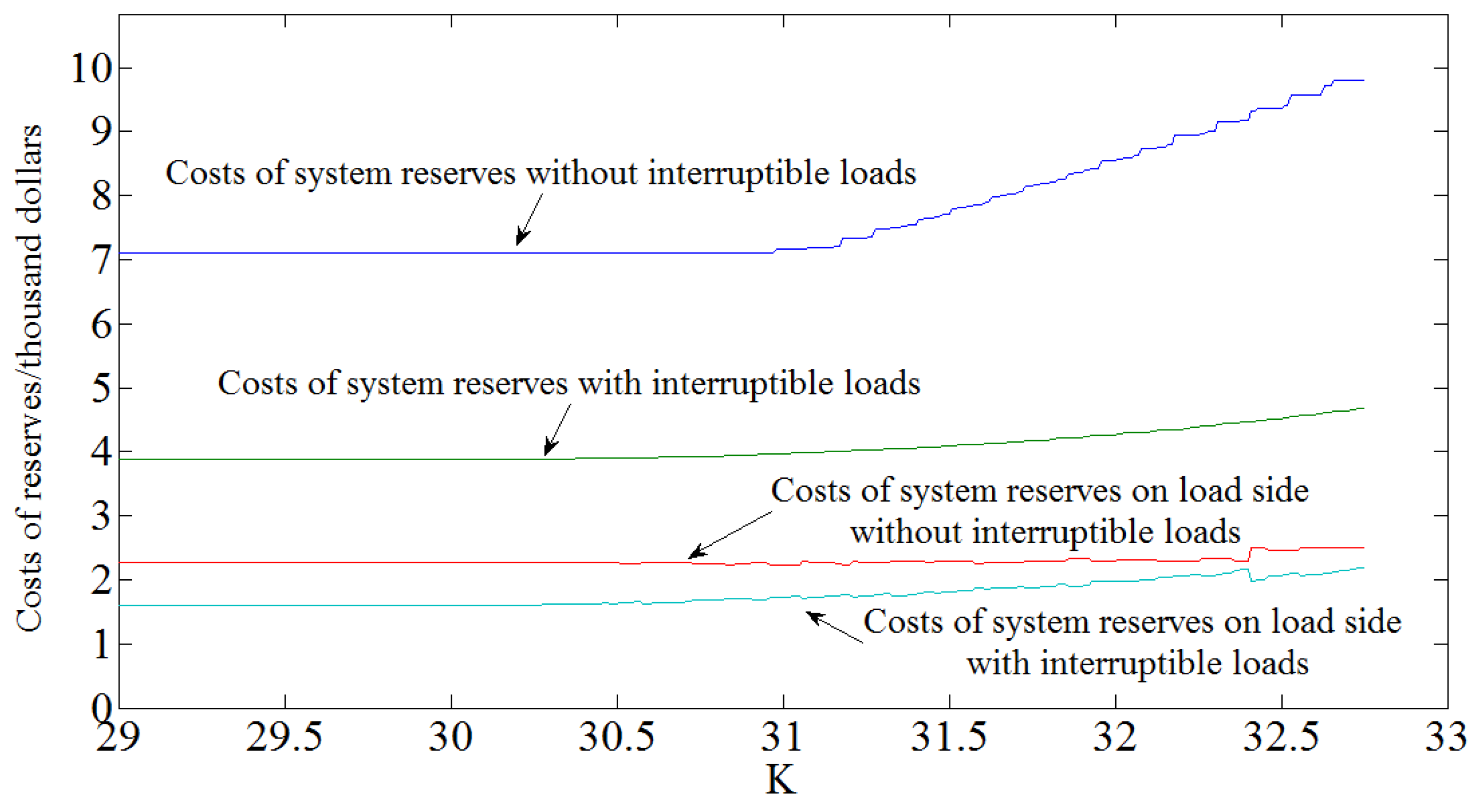
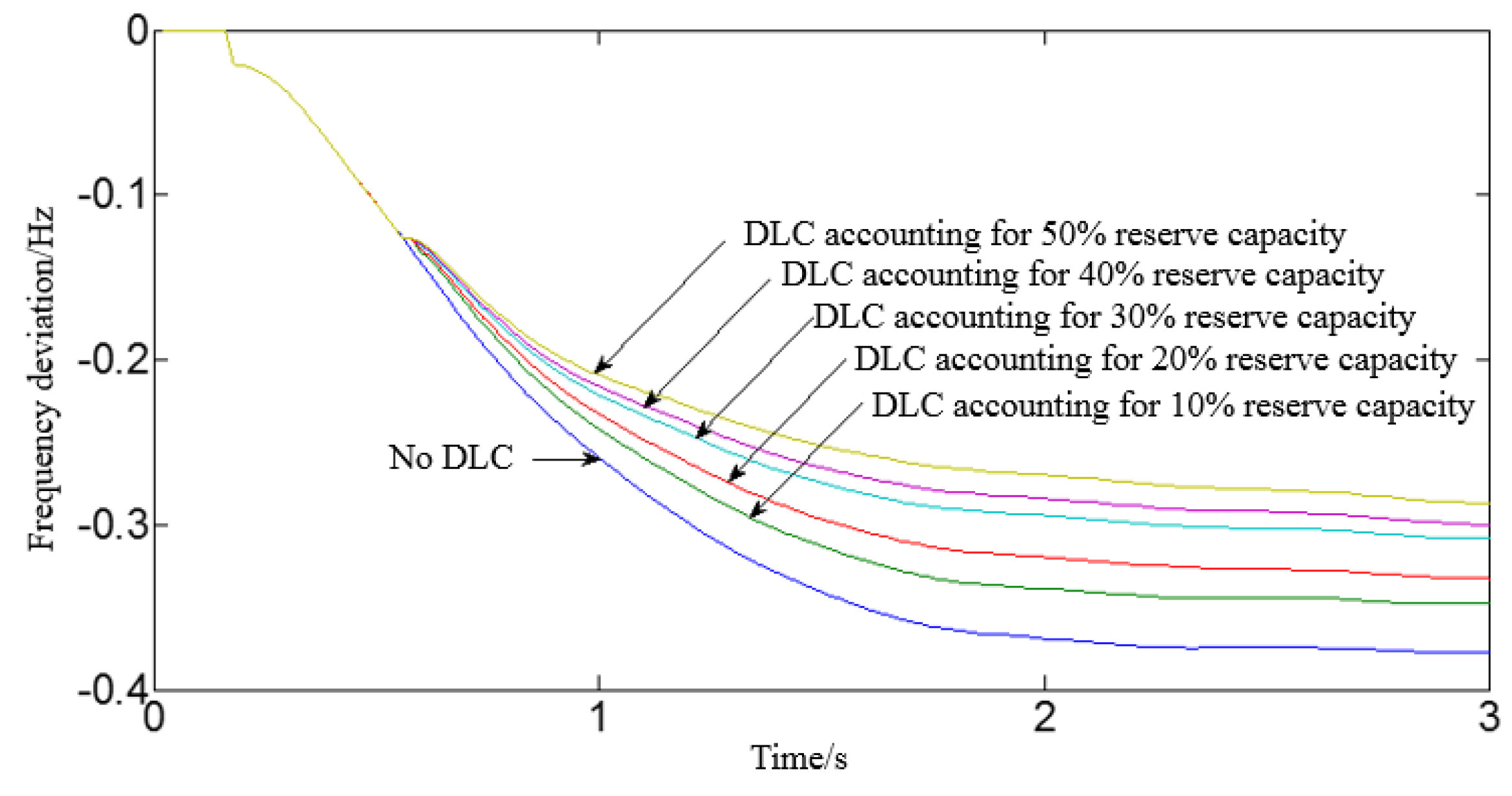
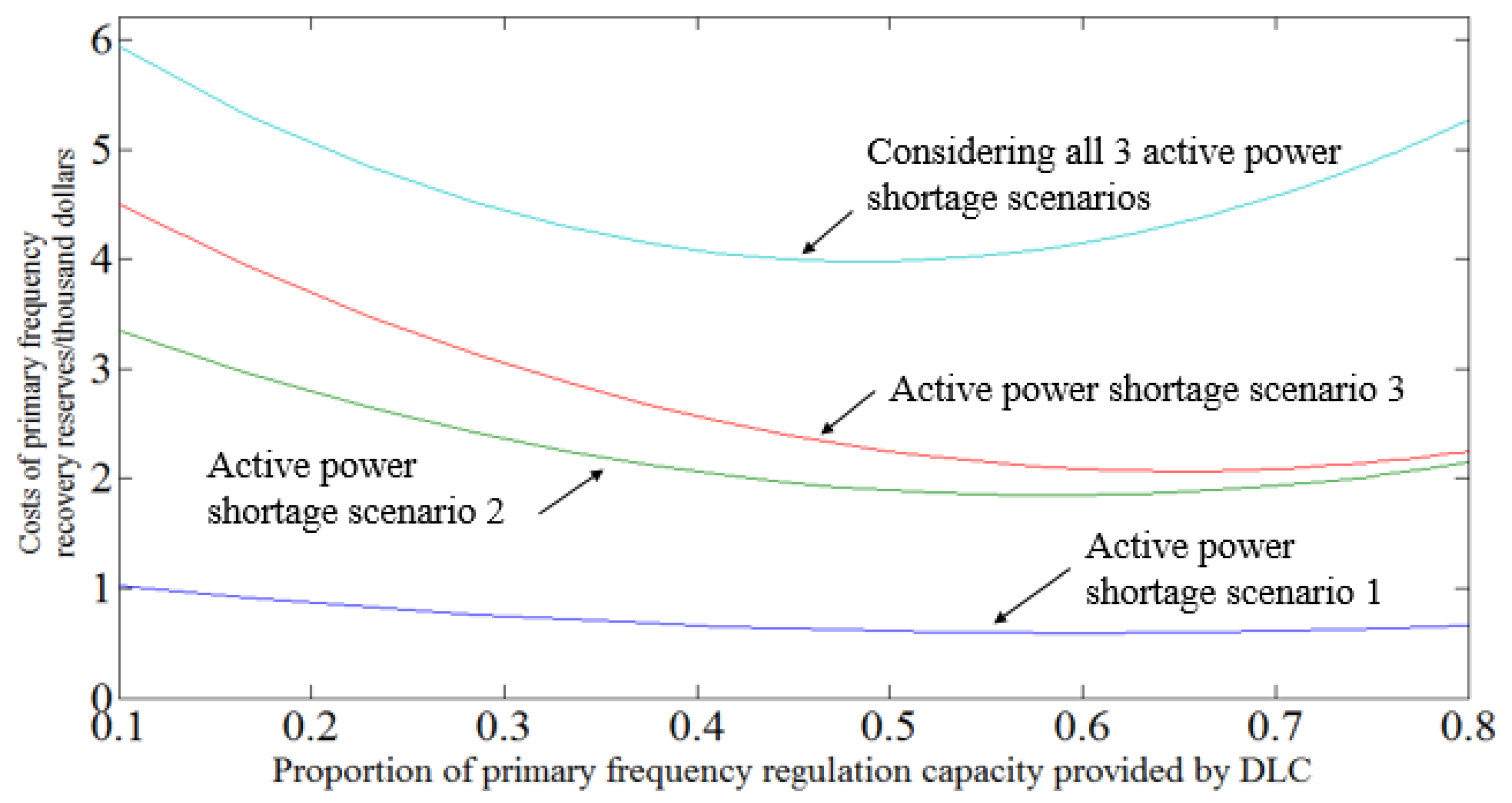
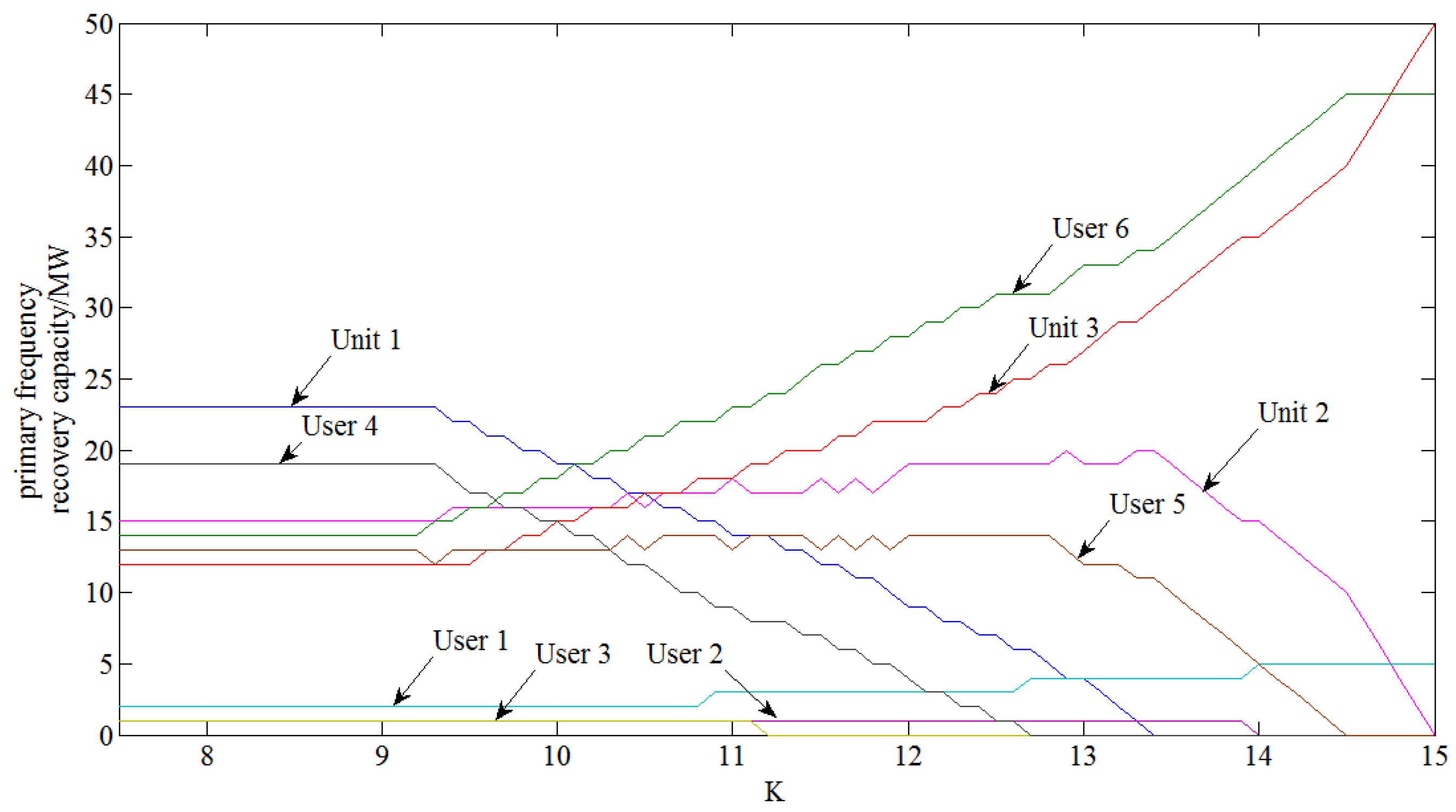
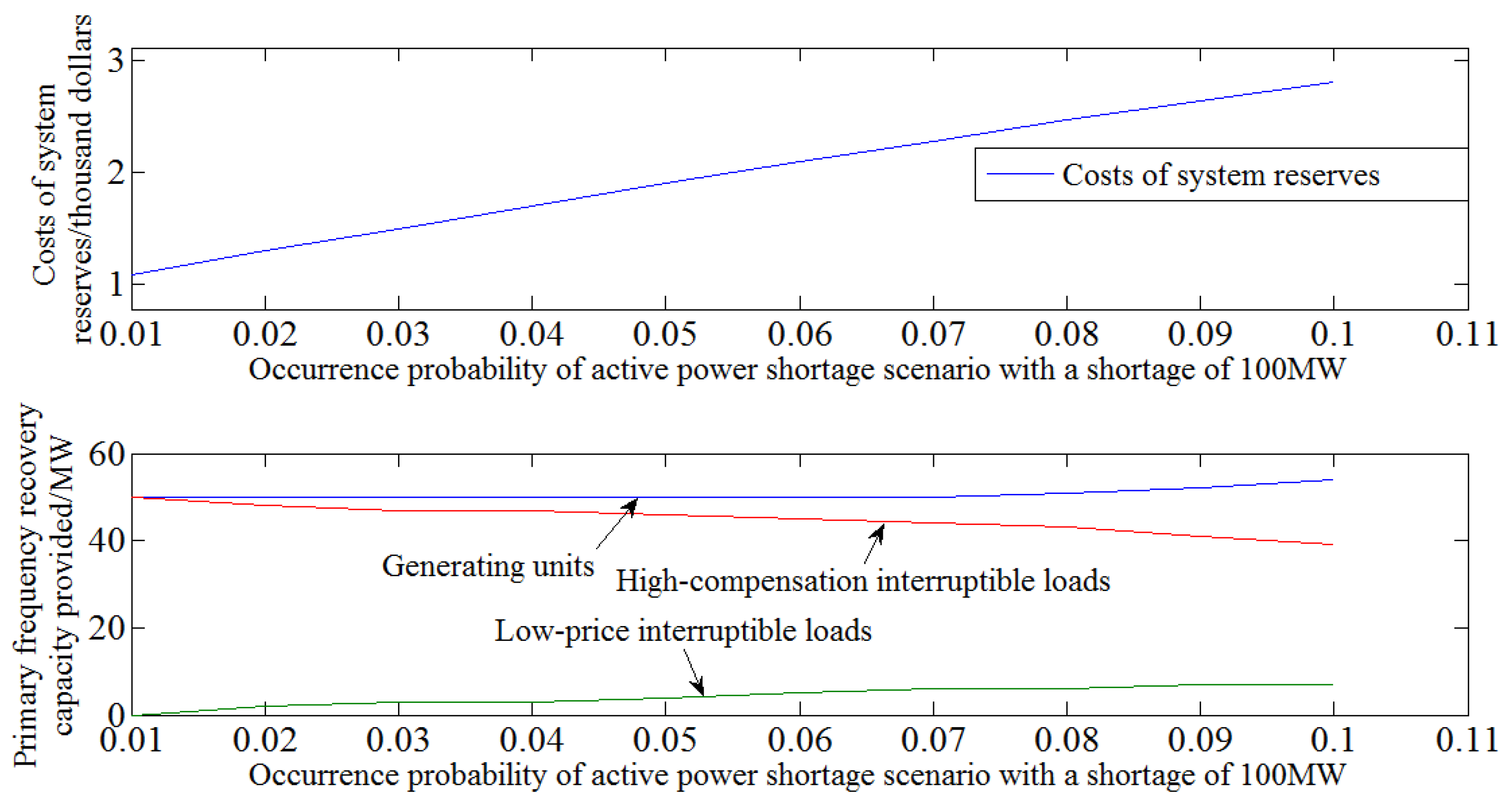
| Generating Unit i | Lower Limit of Spinning Reserve Capacity (MW) | Upper Limit of Spinning Reserve Capacity (MW) | Purchase Bid ci | Invocation Price ($/MWh) | Adjustment Coefficient |
|---|---|---|---|---|---|
| 1 | 0 | 50 | 0.2 | 23.37 | 0.06 |
| 2 | 0 | 50 | 0.3 | 23.52 | 0.04 |
| 3 | 0 | 80 | 0.4 | 23.68 | 0.02 |
| User m | Lower Limit of Interruptible Load (MW) | Upper Limit of Interruptible Load (MW) | Discount Rate of the Electricity Price, bm | Frequency Adjustment Coefficient |
|---|---|---|---|---|
| 1 | 0 | 40 | 0.00625 | 0.01 |
| 2 | 0 | 40 | 0.0075 | 0.02 |
| 3 | 0 | 60 | 0.0083 | 0.03 |
| User n | Lower Limit of Interruptible Load (MW) | Upper Limit of Interruptible Load (MW) | Compensation Coefficient, dn | Frequency Adjustment Coefficient |
|---|---|---|---|---|
| 4 | 0 | 40 | 0.05 | 0.03 |
| 5 | 0 | 40 | 0.075 | 0.02 |
| 6 | 0 | 60 | 0.067 | 0.01 |
| Fault z | Occurrence Probability | Active Power Shortage (MW) | Duration (h) |
|---|---|---|---|
| 1 | 0.1 | 50 | 3 |
| 2 | 0.05 | 100 | 5 |
| 3 | 0.025 | 120 | 7 |
© 2016 by the authors; licensee MDPI, Basel, Switzerland. This article is an open access article distributed under the terms and conditions of the Creative Commons by Attribution (CC-BY) license (http://creativecommons.org/licenses/by/4.0/).
Share and Cite
Zhou, X.; Li, W.; Li, M.; Chen, Q.; Zhang, C.; Yu, J. Effect of the Coordinative Optimization of Interruptible Loads in Primary Frequency Regulation on Frequency Recovery. Energies 2016, 9, 167. https://doi.org/10.3390/en9030167
Zhou X, Li W, Li M, Chen Q, Zhang C, Yu J. Effect of the Coordinative Optimization of Interruptible Loads in Primary Frequency Regulation on Frequency Recovery. Energies. 2016; 9(3):167. https://doi.org/10.3390/en9030167
Chicago/Turabian StyleZhou, Xia, Wei Li, Mengya Li, Qian Chen, Chaohai Zhang, and Jilai Yu. 2016. "Effect of the Coordinative Optimization of Interruptible Loads in Primary Frequency Regulation on Frequency Recovery" Energies 9, no. 3: 167. https://doi.org/10.3390/en9030167
APA StyleZhou, X., Li, W., Li, M., Chen, Q., Zhang, C., & Yu, J. (2016). Effect of the Coordinative Optimization of Interruptible Loads in Primary Frequency Regulation on Frequency Recovery. Energies, 9(3), 167. https://doi.org/10.3390/en9030167





